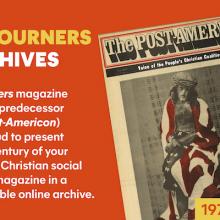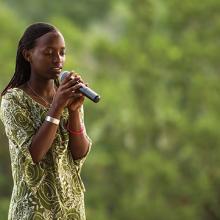Feature

Billion Photos / Shutterstock
NOT LONG AFTER graduating college, I read everything I could find about various expressions of Christian community. Somewhere along the way, I stumbled upon the stories of Dorothy Day, Peter Maurin, and the other Catholic Workers who would follow in their footsteps. I remember being immediately captivated by the Catholic Worker vision for hospitality houses that were community hubs for both action—growing food, feeding the hungry, protesting American militarism—and learning—cultivating conversation and reflection on radical Christian faithfulness and the socioeconomic vision that defined the movement.
Although perhaps more widely admired for their activism and works of mercy, the Catholic Workers have long published a newspaper that is a catalyst for their social vision—fusing the stories of scripture, saints, and literature with the ubiquitous challenge to live faithfully in an age marked by greed and violence. In the words of Maurin, an essential part of their mission is to make “workers out of scholars and scholars out of workers.”
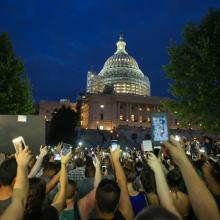
Joseph Gruber / Shutterstock
If I speak about courage and justice, and siding with the oppressed, and speaking truth to power no matter the cost, but do not speak about love ... I am just a loud-mouthed orator, a shameless self-promoter.
If I am excellent at nonviolent communication, and I take great pictures, and I know all the latest anti-oppressive lingo, and I can analyze racist systems so as to dismantle them entirely, but have not love, I am nothing.
If I fully embrace the work of prophet and activist and martyr, and get dragged away by the riot police or bombed by the military of my own country, but have not love, that is no use to anyone.
Love survives evil, war, oppression. Love is patient. It remains when the tear gas clears and the children go back to school. It is still there when the water is protected. Love is kind, not arrogant, not insisting on its own way, but making space for joy and truth even in the hardest circumstance.
Whether it is love between two people, or love of a person for their community, or love of a community for its land, or love of justice and peace and equity, love bears all things, believes all things, hopes all things, endures all things. Love never ends.

Photo via Milles Studio / Shutterstock
I TURN ON THE FAUCET and baptize the collards under ice-cold water for several seconds. I pick the leaves apart with my 12-year-old hands, casting the stems to the side.
A few feet away, my mother reheats her coffee in the microwave and then, between sips, crumbles cornbread and chicken liver into a large, sage-colored bowl. The familiar scent of sweet potato pies dances around the kitchen, along with the unmistakable laughter of my mother on the phone with one of her girlfriends.
Later, I’ll wash and dry the countertop before anointing it with a blanket of white flour in preparation for my mother to make the rolls—my mother’s grandmother’s recipe and the most relished part of the Thanksgiving and Christmas meals. To this day, my mother is one of a few family members who has recorded the secret, something she has always carried with pride.
Some of my first memories about food are stories like this one, at home with my mother conjuring her magic in the kitchen, creating something wonderful out of simple ingredients, as is our legacy as black women. Her food was more than just food; it was nourishment.
Before seminary, before I found language for my womanist theology and politics, before Trayvon Martin and Renisha McBride ushered me into the movement, my hands were actively developing the muscle memory that would later fuel my healing. It took me 15 years to realize that during those times in our kitchen with my mother, I was developing practical tools for my own survival and healing: cutting, peeling, dicing, skinning—not just kitchen duties, but small acts of self-determination.
My addiction to ‘non-food’
I began eating food in secret in high school, mindlessly devouring mini Snickers bars, ice cream, pizza rolls, and French fries in the parking lot at McDonald’s as a way to comfort myself and to avoid what I was truly feeling. When I was stressed or feeling depressed about school or what was going on with my family, I would stuff my face with junk food, making sure to hide the wrappers beneath my mattress.
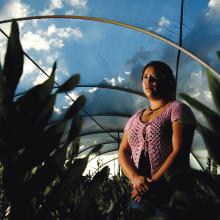
Sarah Reynolds / Southern Poverty Law
HUMAN TRAFFICKING is one of the least morally controversial social justice issues of our time. Agreement that human trafficking is wrong and must end is widespread, if not completely unanimous. Yet when most people hear the term “human trafficking,” they envision sex trafficking: vivid images of young women forced to work in “massage parlors” and brothels, selling sex on the streets of major cities.
But human trafficking is broader than sex trafficking. U.S. law defines human trafficking through the legal categories of fraud, force, or coercion. In simple terms, human trafficking occurs when individuals lose control over their lives and are forced to work for nothing or next to nothing. Someone who has been trafficked does not have control over the terms and conditions of their employment; they can’t leave for fear that they or someone they care about will be harmed as a result.
So while trafficking certainly can take the form of sexual exploitation, it can also look like nannies or janitors, workers in slaughterhouses or meat-packing plants, people forced to work on factory assembly lines and rural farms. It takes place in both the formal and informal economies; it may involve adults and children.
When sex trafficking isn’t
Human trafficking hasn’t always been so tightly linked to sex trafficking. In the 1980s and 1990s, there were a number of nonprofits dedicated to combatting labor exploitation in all its forms. But when one of the first pieces of anti-trafficking legislation was proposed in 1999, its congressional sponsors wished to differentiate between sex-trafficking and other forms of labor exploitation. They “did not want ‘low-wage sweatshop issues’ to cloud the issue of human trafficking, which, they argued, was essentially about the sexual exploitation of women and girls and not about exploited labor more generally,” as Letitia Campbell and I wrote in 2014. Significantly revised anti-trafficking legislation was signed into law in late 2000.
Beginning in 2001, the George W. Bush administration implemented the new anti-trafficking law, making prostitution and sex-trafficking centerpieces of its gender policy. A 2002 National Security Presidential Directive on human trafficking called prostitution “inherently harmful and dehumanizing,” and the administration insisted that prostitution and sex-trafficking are linked phenomena.
Last year in France, Kennecott Copper brought legal suit against the government of Chile in relation to the nationalization of their El Teniente copper mine. In a summation before the French Court, Kennecott lawyers acknowledged that their actions were an exercise in “teaching Chile the political realities of life.” On 11 September 1973, the world watched as Chile learned its lessons well.
On that morning the Chilean Navy seized control of the important port city of Valparaiso and broadcast a demand “that the President of the republic must proceed immediately to hand over his high office to the Chilean armed forces and police.” President Salvador Allende Gossens quickly left for the presidential palace, La Moneda, to repel the second military attempt at coup d’état in four months. From the beginning this one looked more serious. He told his wife over the phone that “there’s an uprising of the navy and many riots in Santiago. I don’t know whether we can resist or not. These are very difficult moments. Let’s hope we come out all right.” As the crisis deepened, Allende increased his determination to see it through to the end. In his public statement, made by radio as two airforce jets screamed over La Moneda, Allende said: “I will not resign. I will not do it. I am ready to resist with whatever means, even at the cost of my life in that this serves as a lesson in the ignominious history of those who have strength, but not reason.”

Konstantin Yolshin / Shutterstock
How could I not? How could I benefit from the messed-up grace of God that allows me to be seen by God on high not as a horrible sinner full and capable of every last deadly sin but as a beloved child and not see others differently myself? It’s messed up, but it’s true.
It’s impossible to laugh, pray, and sing old gospel songs with men who’ve raped and murdered, who’ve sold drugs to children, carjacked strangers, shot girlfriends, buried bodies in woods and not see grace.
I could not look at lines of incarcerated men, ready for a day’s work under the gun (literally), and not shudder at past (and sometimes present) atrocities and injustices. And yet, I could only hope for redemption for this land that no longer grows cotton and for these men who no longer have freedom.
And there’s no way I could rub puppies’ tummies while talking to an inmate-cowboy about dogs, to hear him tell me lots of guys here are like pit bulls because they think they’re tough, but that those guys don’t know—“They’re just silly snuggle bugs,” he says—and me not feel the peace of Christ descend.
I don’t know why. I don’t know how. I just know it’s true: When we visit prisoners, we visit Christ. All during my time in Angola, I saw Jesus everywhere.
JUST A FEW YEARS AGO, Dan Conant was living a life familiar to generations of West Virginians. Born and raised in the state’s Eastern Panhandle, he’d gone to college and left West Virginia to build a career for himself. But Conant, who was working on community solar panel projects in Vermont, couldn’t shake the feeling that he was needed back home, where the shuttering of the coal industry threatened the few employment opportunities that remained.
“It was almost too easy in Vermont,” he recalled. “I needed to be back in West Virginia.”
In 2013, he and his wife, Laura Nagel, a Pittsburgh native, returned to Jefferson County and “Solar Holler,” a crowd-funded venture that installs solar panels for no cost at nonprofits, was born.
“Free, local electricity allows [nonprofits] to put resources toward what matters—including taking care of our neighbors—and creation,” the organization explains on its website.
Solar Holler’s unique crowd-funding model is designed to function within the restrictions of West Virginia’s power industry legislation that, unsurprisingly, favors coal. Nationally, the solar industry relies on tax credits, for which nonprofits in West Virginia are ineligible. Solar Holler’s early efforts to circumvent this barrier—by selling solar panels directly to a church—were shut down by state lawmakers.

Sean Pavone / Shutterstock
ON A HOT DAY in summer 2015, Michael Iafrate stared in distress out the window of a tiny Cessna flying over his native West Virginia.
“What I felt,” he said later, “reminded me of what it’s like when you’re driving along a highway and come upon a bad crash. That twist in your gut, knowing that death is happening here.”
Below him was the Hobet Mine site, 10,000 acres of what was once thickly forested mountains but is now a flat and desolate moonscape—the result of three decades of mountaintop removal mining and one of many such sites that now dot the Appalachian landscape.
“It just kept going and going, mile after mile after mile of blank, ravaged land,” said Iafrate, a 39-year-old doctoral student in theology at the University of Toronto’s St. Michael’s College. Flying so close over the scarred landscape that unrolled below the plane, Iafrate thought of the apostle Thomas touching the wounded side of Jesus. “It felt like an encounter with some wounds of Christ on the earth.”
Iafrate’s flight—provided by SouthWings, a small nonprofit group of pilots that advocates for environmental preservation by providing bird’s-eye views of the results of inaction—was one step in a project he’d been engaged in for several years. But it effectively brought many hours of research and writing into a harsh and visceral focus.
There was more to Iafrate’s anxiety than topography. There was also history, because the text he was working on would become a follow-up to one of the most significant ecclesial statements in U.S. Catholic history. Both the land and the past insisted: He had to get this right.
Listening to the poor in This Land
Back in 1975, the Catholic bishops of Appalachia—a swath of territory, marked by intransigent poverty, that stretches from the northern sections of Mississippi and Alabama up to central New York state—published a major pastoral letter on “powerlessness” in the region. This Land Is Home to Me was the fruit of much groundwork by a group of committed laypeople, religious, and clergy called the Catholic Committee of Appalachia (CCA).

Siarhei Tolak / Shutterstock
JESUS REMINDS the Samaritan woman at the well that she was created for living water—she, the rejected one, was created for water that brings God’s healing, God’s acceptance, God’s wholeness. She was created for God’s peace between ethnic groups. She was created for God’s peace between genders. She was not created for the wilderness. She was created for places where living water springs from the earth and waters everything and everyone in its path. This hardened woman was created to be loved, and to love.
Humanity’s broken relationship with God is the ultimate cause of all other brokenness. It all stands as evidence of the initial break. In another sense, there is no way humanity could violate relationship with any other created being and not violate its relationship with God. All of creation is bound together by one thing: relationship with our Creator. It is Creator God’s love that binds us all together: To break one tie is to break them all.
And it all unraveled, from verse to verse and chapter to chapter. But that was not the end of the story; it was only the beginning. The first humans were tempted to grasp for their own way to peace in the garden, but their futile reach left them emptier than when they began. They reached for peace and received what Jesus called “well water.”
Like the ultimate Harriet Tubman committed to calling humanity to come home—to find the love it was created for—Jesus sits at the well and says to the nameless enemy, “Give me a drink.” And he doesn’t only speak to her heart. He also speaks to her mind. She has real concerns about the rightful place of worship, concerns hewn out of centuries of ethnic strife. Jesus engages her questions.
IN DECEMBER 2007, Naomi Mwangi, a Christian, fled her home in Kisumu, Kenya, as men with machetes attacked towns across the region. For five weeks violence raged nationwide. When the bloodshed ended, more than 1,300 Kenyans were dead and another 650,000 had been displaced. Mwangi and her family ended up living in the Maai Mahiu refugee camp, south of Nairobi. She was 12 years old.
Mwangi is coming of age in a society with ethnic violence in the background, extremist violence in the foreground, and massive economic inequality. Africa has the highest concentration of young people in the world and more than half of them are unemployed. Mwangi wanted something different—she wanted to work for peace.
Now 21, Mwangi is a leader in grassroots peacemaking campaigns that seek to end conflicts between the 42 ethnic groups in this majority-Christian country. The 2007 election violence pitted Christian against Christian, as ethnic ties trumped religious affiliation. Even now, during elections, Mwangi told Sojourners, “Leaders motivate youth to join in the political crisis ... to fight against another tribe.”
A major obstacle to social and economic stability among youth in Kenya is unequal distribution of government-issued identification cards. Kenyans need ID cards for everything from voting and university enrollment to obtaining grants for entrepreneurship programs. But historically, the ruling government doled them out as political favors, and they’ve often been denied to members of minority groups.
“There are plenty of applications at election time,” Mwangi said, explaining that the ID process is slowed down or delayed when it seems one ethnic group could tip the chances of a politician who represents a different group.
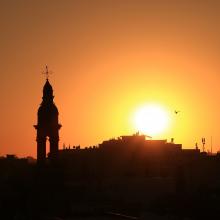
Photo via Fettullah OZASLAN / Shutterstock
IN FALL 1884, the congregation that became Temple Israel opened its doors as the first Jewish synagogue in the state of Nebraska. From its inception, Temple Israel was a Reform congregation, a theologically progressive denomination that stresses the social justice imperatives of Judaism. Yet the early members of Temple Israel included not just Reform Jews, but Conservative and Orthodox Jews as well; navigating these interdenominational relationships would prove to be a significant part of the congregation’s early development.
Fast forward 130 years and Temple Israel is one of three houses of worship embarking on a unique interfaith partnership: a single campus in west Omaha that will house a Jewish synagogue, a Muslim mosque, a Christian church, and a fourth building for interfaith fellowship.
Aryeh Azriel, Temple Israel’s senior rabbi, planted the seeds for this project, known as the Tri-Faith Initiative, in 2006 when he reached out to the American Muslim Institute, another local religious community that was looking to construct a new building.
“The original idea started as a result of looking for a partnership in sharing parking lots,” Azriel told Sojourners.
The two communities had forged a relationship in 2001 when, following the Sept. 11 attacks, Azriel led members of Temple Israel in encircling a local mosque to protect it from the Islamophobic attacks they were seeing in the national news.
Syed Mohiuddin, president of the American Muslim Institute, agreed to the partnership; he liked the idea of the two religious groups sharing a parking lot with each other rather than with retail stores or other commercial development. However, it didn’t take long for the two communities to realize the project had greater potential than a shared parking lot. If they could find Christians willing to join them, they could build a shared campus for all three Abrahamic faiths, the first such campus in the world—at least to their knowledge.

Bangkokhappiness / Shutterstock
A BEEPING, BUSTLING Boston intersection is a strange place for a sanctuary, but on a blustery August evening, the corner of Beacon Street and Massachusetts Avenue becomes just that.
“This is holy ground,” says Rev. Laura Everett to several dozen people who form a semicircle around her and a lily-white bicycle chained to a concrete pole. Flowers overflow from the bike’s front basket.
“We’re here to dedicate this ghost bike,” Everett tells the growing crowd, “a visible sign of an invisible reality—that we’re fragile humans, and we’re only here for a little while.”
Everett, clad in religious vestments, and the crowd around her, wearing bike helmets and messenger bags, are installing the “ghost bike” as a memorial to 38-year-old cyclist Anita Kurmann, a beloved endocrine surgeon in the city, who was killed 13 days earlier when she was struck by a flatbed truck. A cyclist reads Psalm 23 into a megaphone and another reads a letter from Kurmann’s lab supervisor before Everett leads the congregation in a simple call-and-response prayer.
“When we choose to take a bike instead of a car,” Everett prays, “when we choose to listen instead of shout, when we choose advocacy instead of complacency, when we choose to get curious instead of cranky, when we choose to heal a broken world instead of cursing it, when we travel past this spot, remind us of Anita.”
“Holy One,” the crowd responds, some with eyes clenched shut, “hear our prayer.”
It’s a remarkable thing to witness (even on YouTube months later): a Christian minister leading a wildly diverse community of cyclists in prayer and lament for a fallen sister, and for each other. Her bike ministry extends beyond presiding over ghost bike ceremonies, though. Everett—a United Church of Christ minister and executive director of the Massachusetts Council of Churches—leads a “blessing of the bikes” each May where she prays for cyclists’ safety and anoints dozens of sets of wheels with chain lube. And as a four-season commuter cyclist herself who’s officiated three ghost bike ceremonies for fellow cyclists in a little over a year, she’s become a fierce advocate for transportation infrastructure that respects and protects cyclists.

CristinaMuraca / Shutterstock
READERS OFTEN ASK US: How can I incorporate a hunger for justice into my child’s spiritual formation? How do we help the youngest members of the church understand the gospel’s call to love God and to love our neighbors as ourselves? Sojourners asked five Christian parents engaged in various forms of justice work to share their best tips for helping children put their faith into action. Here’s what they said. - The Editors
1. Look for Teachable Moments
by Kate Ott
MANY PARENTS FEEL unprepared to talk about sex or faith with their children. I was one of those parents until I realized age-appropriate sexuality information could empower my children and keep them safe. I also realized that teaching my kids about sexuality meant more than talking about “sex.” After all, if I didn’t talk to my kids about how Christian values of love, justice, and mutuality guide the care of our bodies and our relationship choices, who would?
So rather than planning for a single “big talk” or waiting until I know all the answers, I practice parenting through teachable moments. For example, in our house we talk about how clothing choices and hygiene reflect our thankfulness for our bodies as part of God’s good creation (including remembering to brush teeth!). As a parent, when I take a picture of my kids, I ask them for permission before posting it on social media; this encourages thinking-before-posting and consent as an active yes. And when we’re watching TV or listening to a song in the car about attraction or a relationship, I ask questions like: How would you feel in that situation? Do you think that person values their body? Does that seem like a mutual decision/relationship? Is that kind of love balancing God, neighbor, and self? In the short conversation, I always say something like, “Being in a relationship takes a lot of work and requires communication, honesty, commitment, and mutuality.” This models how to use one’s values to assess relationship choices.
Last year, St. Lydia’s church in Brooklyn, N.Y., started a monthly service that lifts up children’s leadership and participation. They call it Waffle Church, and it’s messy on purpose. Olivia Whitener, an editorial assistant at Sojourners , interviewed Waffle Church minister Sarah McCaslin in January about the service that revolves around songs, stories, maple syrup, and the love of Jesus.
Sojourners: Why waffles?
Rev. Sarah McCaslin: Well, I prefer a savory brunch option, if given the choice. But “Omelet Church” just doesn’t have the same ring. The fact of the matter is: Who doesn’t love a waffle? They’re easy to make, they’re delicious. But the waffles aren’t as important as the idea of this meal we share around the table. It isn’t that we’re going to church and then will have waffles. When we sit around the table together and fellowship together, it’s an extension of communion.
What’s special about a Waffle Church service? The first time we did Waffle Church, I was standing at the table, and I do a rhetorical-question-style liturgy: “Look, we are gathered around this table, and we set it with our finest. This is not the Lutheran table, it’s not St. Lydia’s table, it’s not Waffle Church’s table. Whose table is this?” Then a 6-year-old shouts, “It’s the Lord’s table!” We couldn’t have planned it, and it was just amazing. Of course, now we have to do it because there’s always the kid who wants to shout “It’s the Lord’s table!” And so here’s a piece of the liturgy that has been fixed because the children will demand it. That kind of stuff is just happening all the time.
Are there ways other churches can incorporate a Waffle Church service into their ministries? I think it’s about creating a physical space that can accommodate the needs of children. The music is the other major piece of it. At St. Lydia’s, we adhere to the paperless-music singing tradition, where all of the songs are taught. So there’s no hymnal, no lyrics to be read—those things tend to privilege literacy. This way, children and adults can participate in the music each and every week.
DURING ALL THE Sunday mornings I spent in church as a child, I only cried once. After months of encouragement from my parents, I decided to go to our Catholic parish’s children’s liturgy (their version of Sunday school). I remember nothing else about that morning except that I stood in the corner crying while kind volunteers tried to calm me down with a few cookies. I never went to children’s liturgy again, and I’m thankful the experience didn’t leave me scarred for life, unable to eat another cookie.
My dislike of children’s liturgy wasn’t about what it was; it had to do with what it wasn’t. I grew up watching Mass unfold from the front pew, where I could be as close to the action as possible. Going to the basement meant that I had to give up the beauty, wonder, and fascination I experienced during church services.
It’s been more than 25 years since I lost my composure on that fateful Sunday, and my dissatisfaction with children’s liturgy is now echoed by ministers, Christian educators, and parents who realize the importance of including children in corporate worship. But as I see it, including children in corporate worship isn’t a matter of choice or changing trends; it’s a matter of justice.
“When your children ask you ...”
Practices for including children in worship are far from new. Children’s ministry leaders refer to Deuteronomy 6 so often that memorizing this passage might as well be a prerequisite for working with kids in churches! Many interpretations of this chapter focus on the first few verses—“Keep these words that I am commanding you today in your heart. Recite them to your children ...”—and emphasize the importance of teaching God’s commandments to children in all times and places. Yet a crucial point in this text appears in verse 20, which begins, “When your children ask you ...”

Juergen Faelchle / Shutterstock
How are a poisoned water supply in Flint and water shut-offs in Detroit connected? Tommy Airey, co-editor of RadicalDiscipleship.net, talked with Detroit activists Monica Lewis-Patrick and Cecily McClellan to get the story behind the story.
LONG BEFORE water shut-offs and poisoning in Flint, democracy in much of Michigan had been hijacked. By the time a governor-appointed “emergency manager” was foisted on Detroit in spring 2013, every large black-majority city in Michigan—from Flint to Benton Harbor to Highland Park to Saginaw—had been appointed an EM, stripping all powers from elected leadership while possessing the authority to renegotiate or cancel union contracts, hire and fire government employees, and sell, lease, or privatize local assets.
Two years ago, about the same time that Flint’s EM transferred the city’s water source from Detroit’s water system to the highly toxic Flint River, Detroit’s EM ordered the city water and sewerage department to begin shutting off the water of all Detroiters who were two months or more behind on their water bills.
Today, in a city with 40 percent of its population surviving below the poverty line, Detroit water rates are twice the national average, and an estimated 100,000 residents, including many elderly folks and children, have had their water shut off by the city. The measures are forcing many longtime, low-income residents, the majority of them black, to leave the city.
Since 2008, the grassroots organization We the People of Detroit (WPD), led by five African-American women, has been creatively resisting emergency management—first of the school system and then the entire city—with a steady campaign of awareness-raising, canvassing, water delivery and advocacy for shut-off victims, and a comprehensive mapping project soon to be released.
Monica Lewis-Patrick is the charismatic, energetic point guard of the group, fueled by the Holy Ghost and her morning standard: a cup of coffee sweetened with four sugar packets. Lewis-Patrick, who’s a grandmother and the mother of two teenage daughters, lost her bid for city council two years ago by a few hundred votes. A few weeks later, she lost her only son to gun violence.
Cecily McClellan, the quiet, confident, all-business power forward of Team WPD, is a retired city employee and former vice-president of the Association of Professional and Technical Employees.
I spoke with them at WPD headquarters on the third floor of St. Peter’s Episcopal Church—a stone’s throw from a downtown getting a corporate facelift financed by public bonds, subsidies, and tax abatements to draw companies in from the suburbs, while many residents struggle just to survive and keep their homes. —Tommy Airey
Tommy Airey: Let’s get this straight: Are you advocating for free water for low-income Detroiters?
Monica Lewis-Patrick: Free water has never been the ask. Personally, I’m not opposed to free water. I believe that water is a human right, and that everyone should have access to it. But the ask here in Detroit has always been for affordable water.
What are the mayor’s objections to an affordability plan in Detroit?
Lewis-Patrick: Over the last 11 months, water shut-offs have led to more foreclosures and pushing people out of the city. We believe [city officials] do not want to participate in a water-affordability plan because it would allow more people to stay in the city, especially in communities they want cleared out for future development.
Is this a conspiracy?
Lewis-Patrick: Conspiracy, in my mind, isn’t the appropriate term, because a lot of times people marginalize conspiracy as just somebody’s idea or accusation. What I would say is that it has been a collaborative, well-orchestrated system of evil. We know for a fact, through all the political analysis and economic research that has been done, that the city bankruptcy didn’t have to go down. People saw it as an opportunity to be able to divest from the water department, to weaken the water department intentionally.
Flint was actually advised by the governor and his emergency managers to come off of the Detroit Water and Sewerage Department system and then to become a part of another water system called KWA [Karegnondi Water Authority]. Flint was the largest external customer of the Detroit water system. How is it that you are advising us to become financially solvent, while at the same time all your deeds are making us insolvent?

Kubko / Shutterstock
SO YOU WANT TO HAVE a chat with someone on the other side of the gun control debate, but you’re worried that it could quickly go south, descending into interminable and acrimonious debate. Well, fear not! Here are a few simple guidelines that can help avoid that outcome.
1. Resist false dichotomies
There are a wide range of positions that Americans hold on issues related to gun control. Polls consistently show that most gun owners support some degree of gun regulation. Similarly, few of those who choose not to own a gun believe that, therefore, no one should be allowed to own a gun. Given this, why does the debate so quickly deteriorate to: “You and Obama wanna take my guns!” on the one side and “You folks just don’t care about the gun violence epidemic!” on the other? The first step toward mutually respectful dialogue is to get rid of the false dichotomies.
2. Don’t caricature the other side
It’s an unfortunate part of our everyday discourse that we often attempt to dismiss our opponent’s position by creating an absurd caricature of it. You know the drill. Someone makes a sympathetic comment about gun regulation and the response is: “Oh, so you want to repeal the Second Amendment!” This sort of caricature avoids serious engagement with the issue by recasting it in terms that exaggerate or misrepresent the other’s position. Serious engagement on this issue, or any other, for that matter, requires careful attention to what the person actually says. Resist the temptation to cheapen the discussion by caricaturing the other’s position.

Delmas Lehman / Shutterstock
WHO IS THIS JESUS who rattles my cage and rumbles through the history of my life? This contradictory figure who proves an embarrassment and stumbling block to my mind, but who won’t go away? This man who brings awe and tears to my eyes, who makes me want to resist authority when it’s wrong, who points me to a God who works from the underside of every system of power?
Who is this Jesus? Disturbing teacher of the gospels, comfortable with children and irritating to scholars, unsettling people by his enigmatic stories. Dancing member of the Holy Trinity, looking out from a stunning Russian icon. Object of saccharine devotion in the Sacred Heart of Catholic spirituality, the “Jesus and me” sentimentality of evangelical piety, the unbridled passion of 17th-century metaphysical poets.
He’s the first-century Jewish rabbi of the Jesus Seminar, calling for justice and inclusivity, making no ethereal claims about his own divinity. He’s the Jesus of Jelaluddin Rumi, who wants to be born in the mystical experience of every soul. The Cosmic Christ who weaves his spirit through the fabric of the natural world, causing all things to scintillate with the sacramental, Christic presence of the divine.
He wanders in and out of my reading of Bernard of Clairvaux, Marcus Borg, Dorothy Day, Pierre Teilhard de Chardin, and John Shelby Spong. Each with a finger on the mystery of this figure who pulses back and forth in my life: “Jesus, lover of my soul.” “He walks with me and he talks with me and he tells me I am his own.” “Jesus, the very thought of thee.”
AFRAH ZOUHEIR FLEXES HER HAND as she purposefully stirs a pot of lemon juice, the fruity aroma filling the air as it rises to a boil.
“It needs to be hot in order to mix well with the sugars before it cools down and thickens,” she explains. “Then we bottle it and let it settle into a syrup.”
Zouheir has all of the looks of a professional chef. Her shoulder-length dark brown hair is tied back in a hairnet and her hands are coated in plastic gloves. She wears an apron over her sweatshirt, fanning the air, making sure that the lemon syrup drink she is making smells as it is supposed to; she appears undaunted about managing multiple pots simultaneously simmering over an open fire.
However, this is her first time working in a kitchen—at least professionally. In Mosul, Iraq, where she is from, she was a kindergarten teacher. But when the Islamic State invaded her home city in late 2013 and began targeting religious minorities, including Christians like Zouheir’s family, she grabbed her belongings and fled to Lebanon with her husband and four children. After a short stint in Beirut, the capital city, where rent is expensive and prejudice against refugees, among other factors, makes work hard to come by, she and her husband moved to Falougha, a mountain village where the air is fresh and, most important, the rent is cheap.
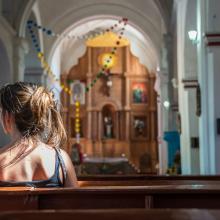
DC_Aperture / Shutterstock
IN OCTOBER 2014, at the age of 35, Ingrid Olson stood before her church of many years. “I am loved,” she told the 80 or so members of her congregation seated in the sanctuary on that Sunday evening. “I am God’s child. I am accepted—completely.” Olson listed other parts of her identity: her curiosity, athleticism, passion for music, Swedish heritage, her tendency to be passive-aggressive. “I am a sister, a daughter, a niece, a granddaughter, a friend,” she continued. Then she added something most people in the church didn’t know: “I am a Christian, lesbian woman.”
Olson is a lifelong member of the Evangelical Covenant Church (ECC), a denomination with Swedish-Pietist roots and 850 congregations in North America. Though the central identity of ECC churches is found in six “affirmations,” including the authority of scripture, the importance of missions, and the experience of personal rebirth, the ECC is not what’s known as an “affirming” church—one that encourages LGBTQ members to participate in the full life of the congregation, including marriage, church leadership, and ordination. Delegates at the 2004 ECC annual meeting voted to make binding a resolution that asserts the “biblically rooted” position on human sexuality is “heterosexual marriage, faithfulness within marriage, abstinence outside of marriage.” While the ECC might not say that being gay is a sin, it would certainly say that pursuing a same-sex relationship is out of the question.
